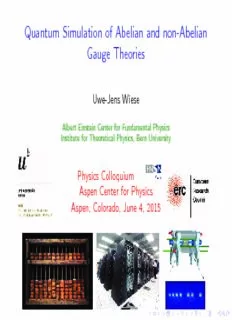
Quantum Simulation of Abelian and non-Abelian Gauge Theories PDF
Preview Quantum Simulation of Abelian and non-Abelian Gauge Theories
Quantum Simulation of Abelian and non-Abelian Gauge Theories Uwe-Jens Wiese AlbertEinsteinCenterforFundamentalPhysics InstituteforTheoreticalPhysics,BernUniversity Physics Colloquium Aspen Center for Physics Aspen, Colorado, June 4, 2015 Bern-Innsbruck Particle Physics AMO Collaboration Innsbruck: Marcello Dalmonte, Catherine Laflamme, Peter Zoller Bilbao: Enrique Rico Ortega Bern: Michael B¨ogli, Pascal Stebler, Philippe Widmer Berlin: Debasish Banerjee Outline A Brief History of Computing Pioneers of Quantum Computing and Quantum Simulation Classical and Quantum Simulations of Quantum Spin Systems From Wilson’s Lattice QCD to Quantum Link Models Quantum Simulators for Abelian Lattice Gauge Theories Quantum Simulators for non-Abelian Gauge Theories Quantum Simulators mimicking “Nuclear” Physics Conclusions Outline A Brief History of Computing Pioneers of Quantum Computing and Quantum Simulation Classical and Quantum Simulations of Quantum Spin Systems From Wilson’s Lattice QCD to Quantum Link Models Quantum Simulators for Abelian Lattice Gauge Theories Quantum Simulators for non-Abelian Gauge Theories Quantum Simulators mimicking “Nuclear” Physics Conclusions The first “analog computer”: Antikythera for determining the position of celestial bodies, Crete, about 100 b.c. The first “digital computer” in Babylonia about 2400 b.c. The first “digital computer” in Babylonia about 2400 b.c. The first “analog computer”: Antikythera for determining the position of celestial bodies, Crete, about 100 b.c. The first “digital computer” in Babylonia about 2400 b.c. The first “analog computer”: Antikythera for determining the position of celestial bodies, Crete, about 100 b.c. The first programmable computer: mechanical “difference engine” Charles Babbage (1791-1871) was realized by his son after Babagge’s death. From the vacuum-tube ENIAC to the IBM Blue Gene Konrad Zuse’s (1910-1992) relay-driven computer Z3 Konrad Zuse’s (1910-1992) relay-driven computer Z3 From the vacuum-tube ENIAC to the IBM Blue Gene
Description: